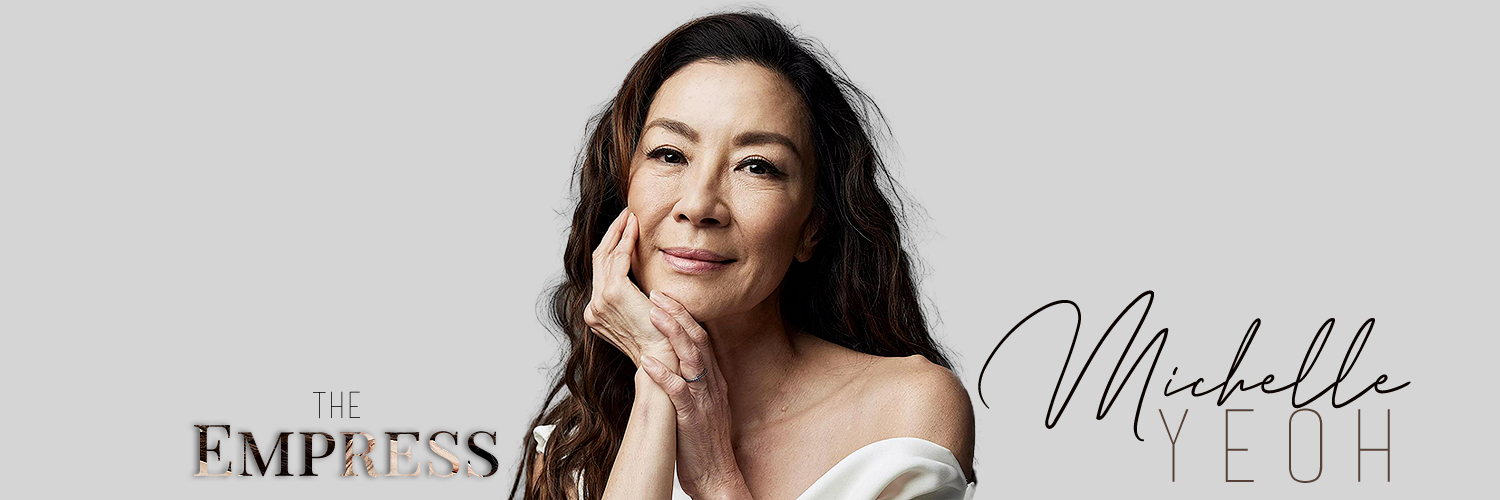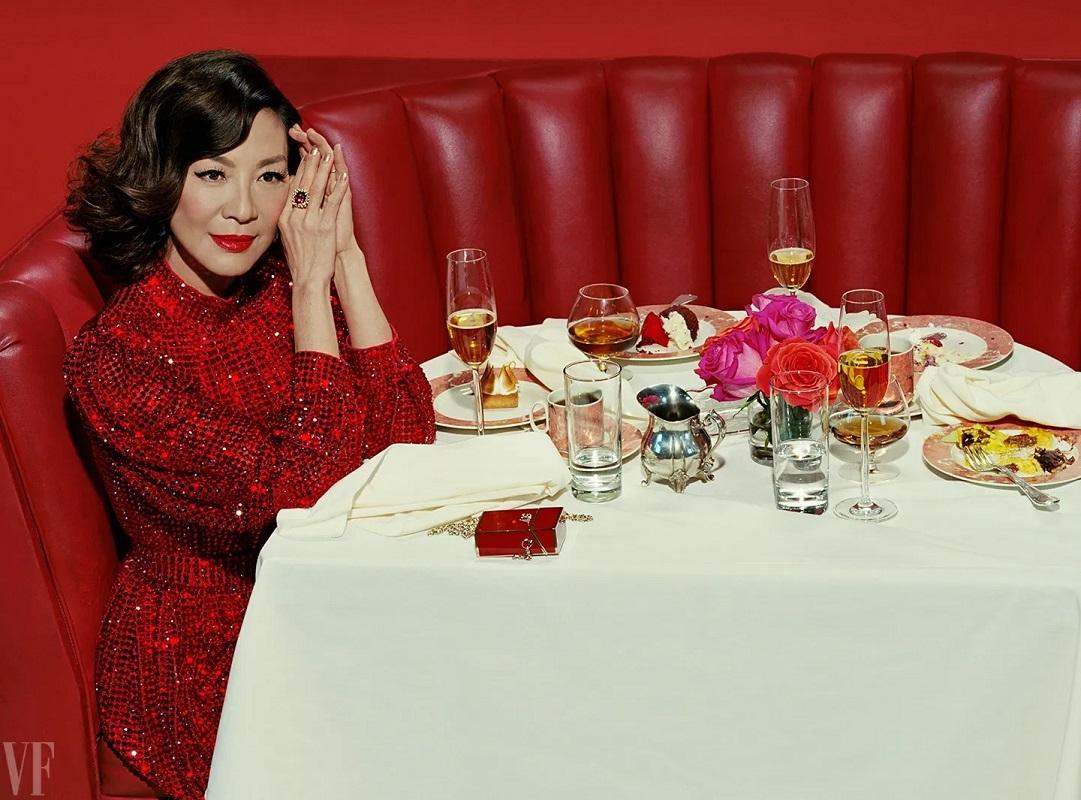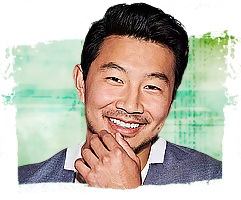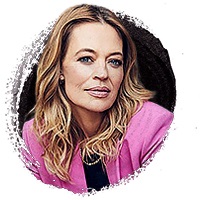
“Sweat or Sink”: The Wit and Wisdom of Michelle Yeoh
Sonia Saraiya
January 14, 2019

The Crazy Rich Asians star knows a thing or two about pain.
For a woman who spends most of her time on-screen suffering, Michelle Yeoh is remarkably cheerful. In person, she is tiny. Her powerful body, which flew across the sky in Crouching Tiger, Hidden Dragon and crashed a motorcycle while handcuffed to Pierce Brosnan in Tomorrow Never Dies, is wiry and delicate. Only her slightly mincing gait reveals how much her body has been capable of; she walks carefully, with a permanent turnout, like a retired ballet instructor.
In fact, Yeoh came to martial-arts performance through dance. After winning the Miss Malaysia crown in 1983, Yeoh moved to Hong Kong to start making movies.“My first movie with Sammo Hung, the guys were doing all the action and the girls were the damsels in distress,” she told me recently. Yeoh, who was an athletic dancer while growing up in Malaysia, saw the fighting and thought to herself, “This is like choreography.”
At the Four Seasons in Manhattan, Yeoh is drinking coffee and promoting Crazy Rich Asians—a film she carries, even though her only action scene is around a mahjong table. (It’s a tense scene, but it’s no jumping off a skyscraper while attached to James Bond.) Yeoh likes mahjong, and she plays it for fun. “When you play it, you have a flair—how you move, how you use your hands,” she said. Sometimes she and her friends go crazy: they wear all their rings as they shuffle the tiles, to amplify the clacking.
It’s been over 20 years since Yeoh’s turn as a Bond girl, and yet it’s only now—with the attention around Crazy Rich Asians, and a TV role as a powerful Starfleet captain on Star Trek: Discovery—that Yeoh is basking in the American spotlight. On Monday, CBS confirmed that Yeoh will star in her own Star Trek spin-off, reprising her role as Philippa Georgiou. In the official release, Yeoh is quoted: “I can’t wait to see where it all goes—certainly I believe it will go ‘where no WOMAN has ever gone before!’” The former pageant queen has a regal bearing and a quick laugh, burbling with amusement when she describes the slapdash filmmaking methods common in Hong Kong cinema when she was first starting out. It’s quite a contrast to the characters she has typically played: stoic action stars, or grave, long-suffering women. It’s as if the lens of pain is the only way she can be seen or understood on-screen, as if her implacable endurance redeems the damage done to her characters. Yeoh’s performances lend depth to women who are repressed by duty, and she’s so good that when watching her, it’s possible to forget what has caused the pain in the first place.
The night before we spoke, director Ang Lee introduced a special screening of Crazy Rich Asians at the Museum of the Moving Image by reminiscing with Yeoh about the filming of Crouching Tiger, Hidden Dragon—the Oscar-winning global hit that cemented his career. While filming stunts, Yeoh tore her anterior cruciate ligament, one of the major ligaments that stabilizes the knee joint. Yeoh took two months to recover; when she returned to set, she could only do stationary scenes. The first she shot upon her return was the most important one in the movie: its finalé, where Yeoh’s character, Yu Shu Lien, cradles the man she loves, played by Chow Yun-Fat, as he dies in her arms.
In Lee’s telling, the production, by that point, felt fraught. Yeoh’s injury had forced rescheduling, and Cantonese speakers Yeoh and Chow struggled with the Mandarin dialogue. Lee hid it from his actors, but he was having doubts about the future of his movie, no matter how visionary it seemed in his mind. To add insult to injury, when Yeoh was seated in the shot, her immobilized, healing knee had to be propped up on a stool at a wild angle. Lee had to shoot it close-up to preserve the illusion. They did four takes that day; Lee knew he got the performance he wanted from Yeoh on the third. “I had to go away and cry for 15 minutes,” Lee said. “I could feel the pain she was carrying.” (Onstage, Yeoh deflected this seriousness with a charming little quip—and for a moment, she was fully the former Miss Malaysia, poised and with a slight diva drawl: “Good thing I was flexible.”)
Pain, and carrying it, have been central to Yeoh’s career. Her work in the Hong Kong action-movie industry required formidable physicality, yes. But the dramatic roles she’s excelled in are also ones in which women—Asian women—are called to contain their pain and suffering, as duty and society requires. In Memoirs of a Geisha, she teamed up once again with Crouching Tiger star Ziyi Zhang to play an experienced Japanese courtesan; in Luc Besson’s The Lady, she played the long-imprisoned Burmese politician Aung San Suu Kyi. In Crouching Tiger, the weight of loss, duty, and unfulfilled love make a mask out of her fine features, until finally, in the very last minutes of the movie, the pain pours out of her.
And in Crazy Rich Asians, which is currently in the endgame-stage of its push for recognition from the Academy, Yeoh’s character, Eleanor, is a stand-in for centuries of sacrifice, tradition, and propriety, as much as one person can be. The final scene of that movie is carried by a casual glance from Yeoh, who reluctantly gives her son (Henry Golding) permission to marry his American girlfriend (Constance Wu). The movie is a confection of Singaporean delights; it’s Wu and Yeoh who turn it into a character drama about identity, legacy, and wealth. Yeoh’s Eleanor is both achingly sympathetic and absolutely terrifying, a pillar of iron. You can criticize her methods, but it’s impossible to underestimate her.
Yeoh has the scars to prove it. Onstage, Lee regaled the audience with descriptions of the bruises he’s seen on her—purple marks the size of continents, from slamming into walls while suspended by wires. But when he expressed a trace of guilt—“I didn’t know until we wrapped,” he says—she shut him down. “There’s no point telling you! We still have to do it,” she replied, businesslike. In Hong Kong, no one would admit to being hurt after a shot. “You could be bleeding from the head, but the first thing you’d say is ‘I’m O.K.! I’m O.K.!’”
“I put myself there,” Yeoh said to me the next morning, unruffled. It was dangerous, but it was the environment she wanted to compete in. At the time, Yeoh said, Hong Kong’s action scene “was very much a man’s world.” Her determination to become a female action star—in a moment dominated by male stars Jackie Chan and Jet Li—made her an object of fascination. When she went to the gym where the stuntmen trained, other performers immediately noticed. She imitated their jeers: “‘Really? A Miss Malaysia? She wants to be action?’ I had to prove I was tough enough, quick enough. Well-known action stars would come and visit the set and just watch.”
Her Cantonese was bad, she knew, and she couldn’t even read Chinese—but that didn’t matter, because the movies were written on the fly. Shoots would end Wednesday, in time for a Friday film release. Safety standards in Hong Kong at the time were also lax; Yeoh did stunts on revving motorcycles without fully knowing how to operate them. When she and Chan were promoting a movie together, the American press assumed scenes they’d shot on a moving train had been filmed in front of a greenscreen—because they looked too patently dangerous to be real stunts.
In another scene, Yeoh had to pull out a gun and aim it through the open window of a car door; the only direction she was given was “power!” She slammed her forearm into the door so many times that the director eventually halted the scene—thinking that the bruises blooming on her skin was dirt that needed to be washed off.
Yeoh has and had the professional advantage of possessing an unquenchable zeal for testing her own limits. She described those early years as the “deep end,” where she could either sweat or sink.
“I’m glad I did it then—I was crazy enough to do it then,” she said, wryly. But Yeoh’s stories also indicate that if she wanted to succeed in that particular industry, there wasn’t much choice: “You are hospitalized, you are the one who is in pain. But you set a bar for yourself.”
It’s that long history of bringing pain to the screen that makes her role in Crazy Rich Asians so wonderful. Eleanor’s experience is the counter-narrative to the extravaganza of wealth that otherwise characterizes the film: her disapproval of Wu’s Rachel stems from the days when Eleanor was the naive daughter-in-law trying to impress her future mother-in-law, played by Lisa Lu. In the film, Lu’s character is a grandmotherly woman who makes fresh dumplings and still doesn’t approve of Eleanor. Yeoh’s face, in the moments she is rebuked by Lu, reflects a remarkable range of hurt.
Originally, Yeoh told me, the script’s version of Eleanor was mean and rigid. But the actress and director Jon M. Chu worked to make her a tragic figure, not a villain—someone who can ultimately bend the oppressive duty and overbearing tradition that crushes her, albeit just a bit. After seeing the film, “son-in-laws will come up to me and say, maybe I understand my mother-in-law better now. Maybe she’s not so mean,” Yeoh said, proudly. I get it: She’s showing us where pain—so universal and ubiquitous—has, for once, receded.









